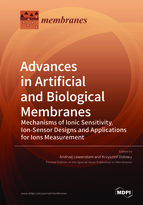Advances in Artificial and Biological Membranes: Mechanisms of Ionic Sensitivity, Ion-Sensor Designs and Applications for Ions Measurement
A special issue of Membranes (ISSN 2077-0375). This special issue belongs to the section "Membrane Applications".
Deadline for manuscript submissions: closed (31 July 2020) | Viewed by 37601
Special Issue Editors
2. Johan Gadolin Process Chemistry Centre, c/o Centre for Process Analytical Chemistry and Sensor Technology (ProSens), Åbo Akademi University, Biskopsgatan 8, 20500 Åbo-Turku, Finland
Interests: sensor technology; electroanalysis; analytical/clinical chemistry; ion-selective electrodes; ion-sensor architectures; membranes and electroactive materials for ion-sensors
Special Issues, Collections and Topics in MDPI journals
Interests: biological membranes; ion channels and transporters; epithelial transport of ions and water; mitochondria bioelectrochemistry; sensors; microfluidic systems; mathematical modeling
Special Issues, Collections and Topics in MDPI journals
Special Issue Information
Dear Colleagues,
Ion-sensors, conventionally known as ion-selective membrane electrodes, were founded a hundred years ago by the invention of a pH electrode with a glass membrane (in 1906 Cremer, in 1909 Haber and Klemensiewicz). That electrode type had a symmetric design with an internal contact made by a solution.
Today there are many membranes made of glass, solid-state, plastics, and composites, as well numerous internal contacts made of conducting polymers, carbon nanotubes, graphene, conducting clays, and composites. For this reason, the sensors can be miniaturized; made service-free; and produced by a mass fabrication technique, such as 3D printing. Responses are now treated by models that are able to the access time-and-space domains of the sensors. Supported by advanced modeling, the ion-sensors are now deliberately calibration-free, and they may undergo automatic quality check. The sensors can act in ad hoc and routine applications theaters, hospitals, sports, water control, etc.
The heart of the ion-sensors is always the same: a membrane that is able to develop the ion-response due to selective, fast, and reversible ion-exchange at the sample–membrane interface. The membrane can be artificial or biological.
The aim of this Special Issue is to present novel waves and to show the progress that has been made recently in ion-sensor technology. All aspects that contribute to successful advancements of the design, understanding, and application of ion-sensors are of interest. I look forward to receiving your contributions. The submission site is ready to receive your contributions to sensors science.
Prof. Andrzej Lewenstam
Prof. Krzysztof Dołowy
Guest Editors
Manuscript Submission Information
Manuscripts should be submitted online at www.mdpi.com by registering and logging in to this website. Once you are registered, click here to go to the submission form. Manuscripts can be submitted until the deadline. All submissions that pass pre-check are peer-reviewed. Accepted papers will be published continuously in the journal (as soon as accepted) and will be listed together on the special issue website. Research articles, review articles as well as short communications are invited. For planned papers, a title and short abstract (about 100 words) can be sent to the Editorial Office for announcement on this website.
Submitted manuscripts should not have been published previously, nor be under consideration for publication elsewhere (except conference proceedings papers). All manuscripts are thoroughly refereed through a single-blind peer-review process. A guide for authors and other relevant information for submission of manuscripts is available on the Instructions for Authors page. Membranes is an international peer-reviewed open access monthly journal published by MDPI.
Please visit the Instructions for Authors page before submitting a manuscript. The Article Processing Charge (APC) for publication in this open access journal is 2700 CHF (Swiss Francs). Submitted papers should be well formatted and use good English. Authors may use MDPI's English editing service prior to publication or during author revisions.
Keywords
- Ion-sensor architectures
- Membranes and electroactive materials for ion-sensors
- New fabrication schemes
- Response interpretation and modeling
- New applications: wearable, disposable, remotely controlled ion-sensors
- Routine ion-sensors application
Related Special Issue
- Advances in Artificial and Biological Membranes, Volume II in Membranes (15 articles)








